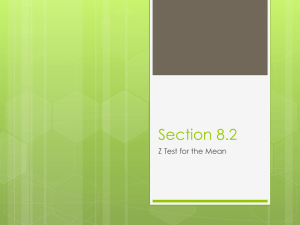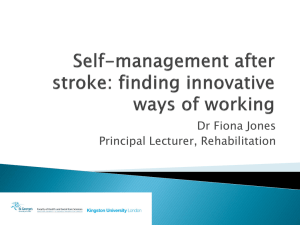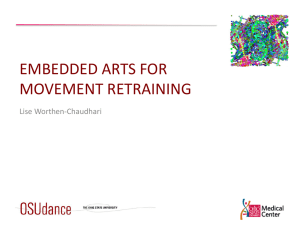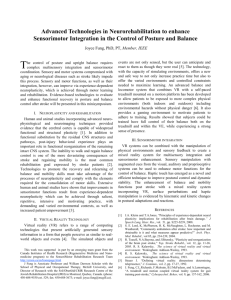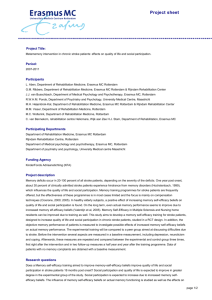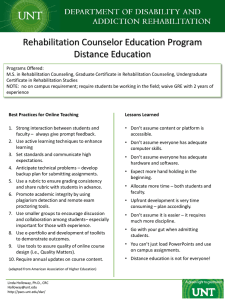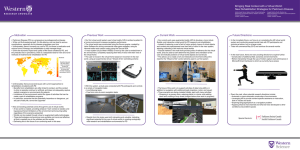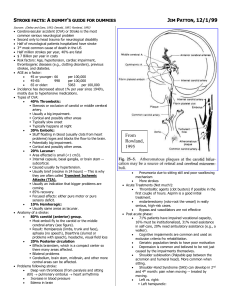Computer games for rehabilitation
advertisement
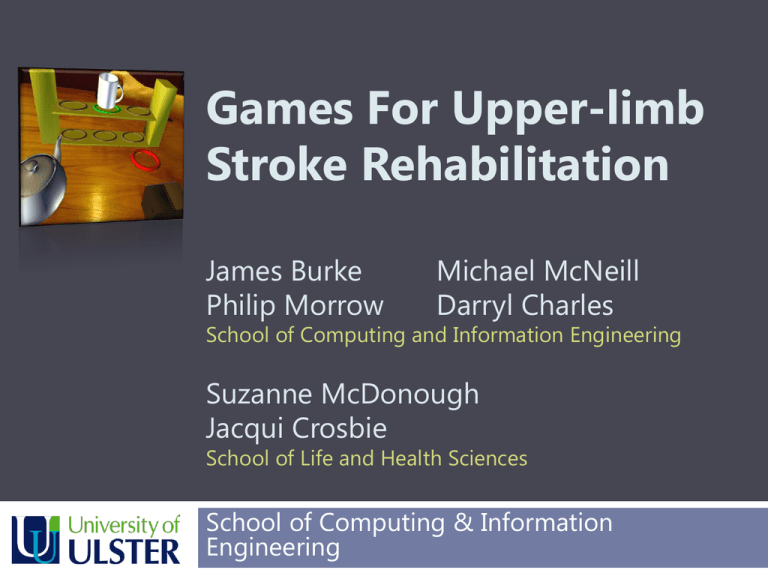
Games For Upper-limb Stroke Rehabilitation James Burke Philip Morrow Michael McNeill Darryl Charles School of Computing and Information Engineering Suzanne McDonough Jacqui Crosbie School of Life and Health Sciences School of Computing & Information Engineering Research Overview The Problem Area: Stroke is a leading cause of severe physical disability.1 Difficult to provide optimal therapy for patient’s needs. Difficult to maintain patient motivation.2 Upper limb remains weak in up to 66% cases.3 The Proposed Solution: Technology has been applied to stroke rehabilitation in many studies.4 Video games may be effective in optimising engagement & motivation. 1. British Heart Foundation & Stroke Association (2009) Stroke Statistics. http://tinyurl.com/stroke09 2. Burdea (2002) "Key note address: Virtual rehabilitation – benefits and challenges." 3. Van der Lee et al. (1999) “Forced use of the upper extremity in chronic stroke patients”. 4. Crosbie et al. (2007) "Virtual Reality in Stroke Rehabilitation: Still More Virtual Than Real". Game Design for Stroke Rehab Video games are well known as a means of providing excitement, stimulation, motivation, challenge and enjoyment. “Designers of rehabilitation tasks can benefit from examining the formulas that commercial game developers use…” 1 Three important principles selected for rehabilitation: Meaningful Play Appropriate level of challenge Handling Failure 1. Rizzo & Kim (2005) “A SWOT analysis of the field of virtual reality rehabilitation and therapy”. Game Design Principles Meaningful Play Inputs choices Player Meaningful play Game Feedback Discernable and integrated outcome & Goals 1, 2 Maintaining Challenge Appropriately Match patient abilities. How to maintain challenge? How to handle failure? 1. Csikszentmihalyi (1988) “Optimal Experience: Psychological Studies of Flow in Consciousness”. 2. Rabin (2005) “Introduction to Game Development”. Webcam Games Low cost game system. Contains multiple games which share a stored player profile. Single and bimanual arm rehabilitation. Tracks a coloured glove or mitt with any standard webcam - intuitive controls. Play standing or seated. Dynamic level of challenge. Clear and consistent user interface. No attaching of wires required. Potential for home rehabilitation. Webcam Games L R Player Movement Wearing Gloves Image Captured by USB Webcam Image Processed – Pixels identified for each glove Output to Monitor / Projector Webcam Games Video View at: http://www.youtube.com/watch?v=1_QH1a0AziA Evaluation of Webcam Games Initial phase – Evaluation with able-bodied users. Phase 2 – Single play evaluation with stroke users: Three participants recruited with varying degrees of movement. Played each game a number of times and filled out questionnaire on usability (including playability). All participants were able to play well, displayed enthusiasm and enjoyed the games. Some expressed interest in obtaining the games for home use. Phase 3 – Three week single user case studies. Augmented Reality Games Marker-Based AR. Markers tracked via image from standard webcam. Real-world image augmented with virtual elements. Allows use of physical objects of varying size, shape and weight. Rehabilitate high quality motor skills which are more transferable to activities of daily living? Augmented Reality Prototype Games Video View at: http://www.youtube.com/watch?v=clSGq8C0JyM Final Remarks Ongoing & Future Work: Develop the games further. Overcome issues (camera placement, dealing better with occlusion, depth perception aids). Evaluation of games with able-bodied users and people with stroke. Conclusion: Games have potential to engage and motivate during rehabilitation. Low-cost off-the-shelf hardware may offer an opportunity for home rehabilitation in addition to traditional therapy. Augmented reality offers opportunity for rehabilitation of meaningful skills. Questions? Michael McNeill mdj.mcneill@ulster.ac.uk James Burke burke-j5@email.ulster.ac.uk Darryl Charles dk.charles@ulster.ac.uk

